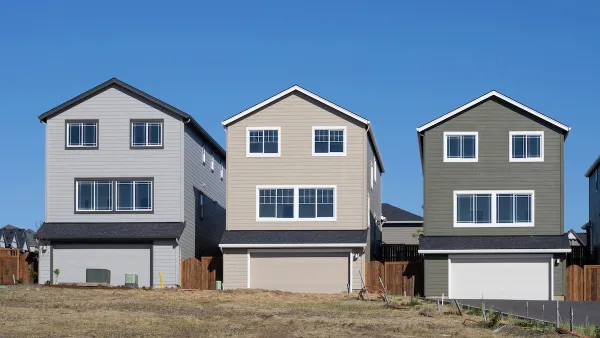Recent analysis shows that Americans are less willing to pay extra for large houses. It's information best viewed skeptically, but it's also worth considering why this trend has finally, semmingly swung the other way.

Joe Cortright continues an ongoing crusade to elucidate the facts about the creation and consumption of McMansions in the housing market.
Cortright's commentary follows a round of "downbeat" stories about the demand for McMansions. Stories from Bloomberg and the Chicago Tribune followed the lead of Trulia's Ralph McLaughlin, who compared price trajectories of 3,000- to 5,000-square-foot homes built between 2001 and 2007 with all other homes in each metropolitan area. "McLaughlin found that since 2012, the premium that buyers paid for these big houses fell pretty sharply in most major metropolitan markets around the country," explains Cortright. "Overall, the big house premium fell from about 137 percent in 2012 to 118 percent this year."
According to Cortright, the falling premiums for McMansions might have to do with the aging process: "Like new cars, McMansions may have their highest value when they leave the showroom…" But according to Cortright, another factor could also be working against the McMansion: as demand for urban, walkable areas has increased, demand for McMansions built on the periphery of metropolitan areas has not gone unscathed.
Finally, says Cortright, the market factors that drove the boom in McMansions in the bubble years just no longer exist.
The bad news for the McMansion market is new—Planetizen was picking up stories that reported of a renewed trend toward houses of larger and larger sizes around the United States as recently as July of 2016 (and also in June 2014). Cortright, however, offered a dissenting opinion about how the real estate's data skewed toward a false portrayal of McMansion dominance in the market.
FULL STORY: McMansions Fading Away?

Analysis: Cybertruck Fatality Rate Far Exceeds That of Ford Pinto
The Tesla Cybertruck was recalled seven times last year.

National Parks Layoffs Will Cause Communities to Lose Billions
Thousands of essential park workers were laid off this week, just before the busy spring break season.

Retro-silient?: America’s First “Eco-burb,” The Woodlands Turns 50
A master-planned community north of Houston offers lessons on green infrastructure and resilient design, but falls short of its founder’s lofty affordability and walkability goals.

Test News Post 1
This is a summary

Analysis: Cybertruck Fatality Rate Far Exceeds That of Ford Pinto
The Tesla Cybertruck was recalled seven times last year.

Test News Headline 46
Test for the image on the front page.
Urban Design for Planners 1: Software Tools
This six-course series explores essential urban design concepts using open source software and equips planners with the tools they need to participate fully in the urban design process.
Planning for Universal Design
Learn the tools for implementing Universal Design in planning regulations.
EMC Planning Group, Inc.
Planetizen
Planetizen
Mpact (formerly Rail~Volution)
Great Falls Development Authority, Inc.
HUDs Office of Policy Development and Research
NYU Wagner Graduate School of Public Service




























